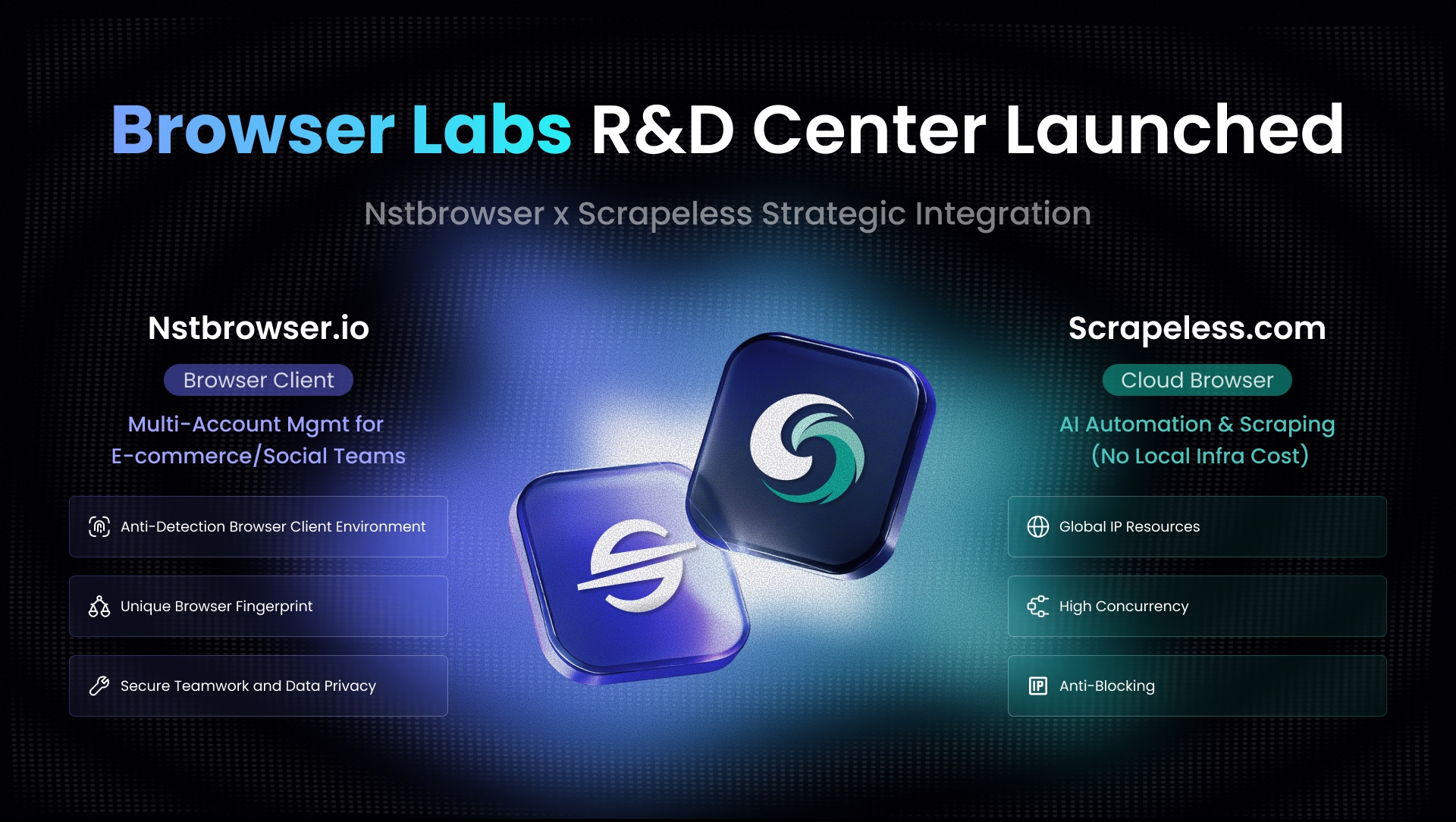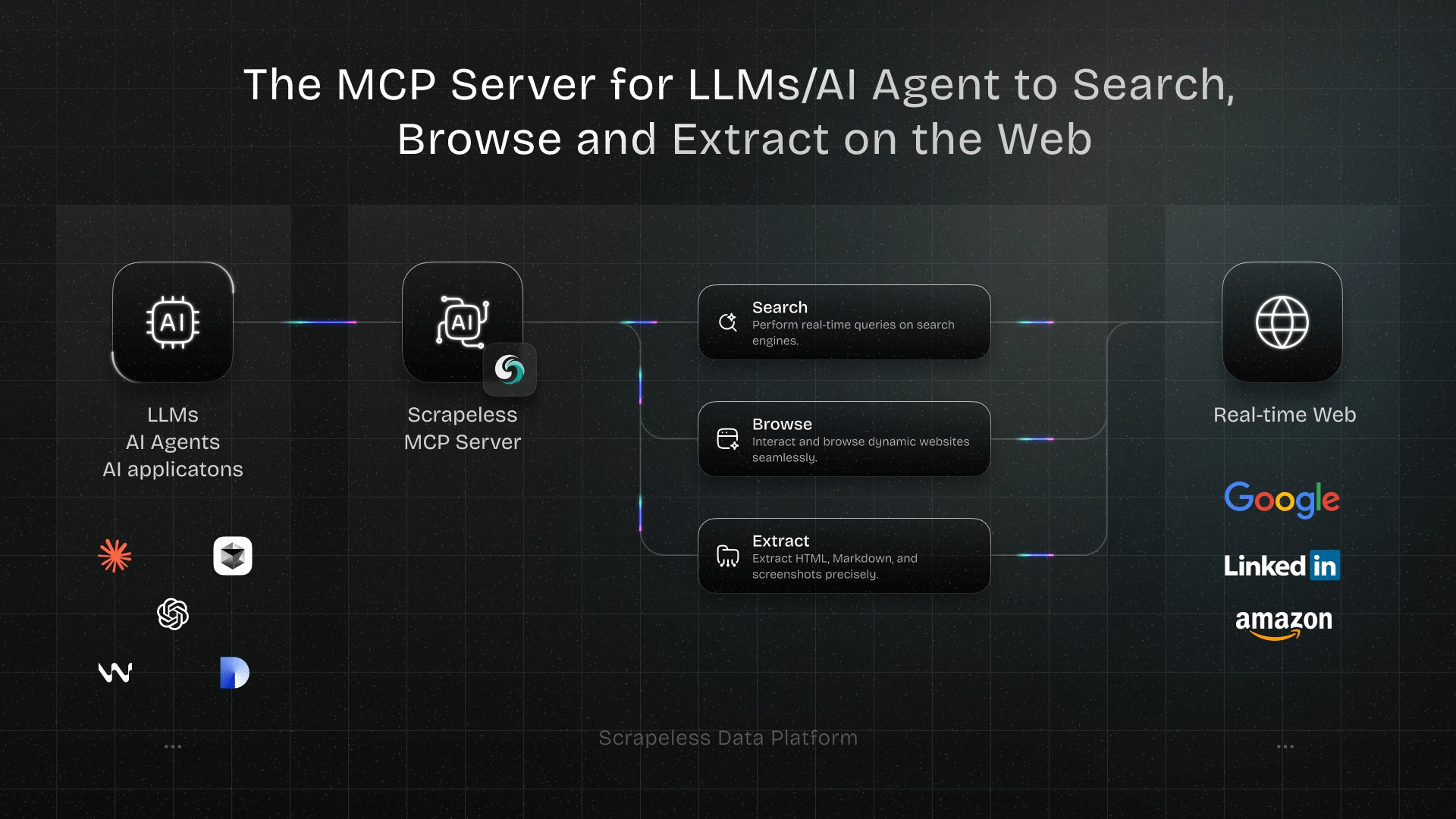What Is Web Scraping? Definitive Guide 2025
Advanced Data Extraction Specialist
Key Takeaways:
- Web scraping automates data extraction from websites, transforming unstructured web content into structured, usable formats.
- It's crucial for market research, competitive analysis, lead generation, and powering AI/ML models.
- Various methods exist, from simple manual techniques to advanced automated solutions using programming languages and specialized tools.
- Ethical considerations and legal compliance are paramount to responsible web scraping.
- Scrapeless offers a powerful, efficient, and scalable alternative to traditional scraping methods, simplifying complex data extraction tasks.
Introduction
Web scraping is the automated process of extracting data from websites. It converts unstructured web content into structured formats like spreadsheets or databases. This guide delves into the intricacies of web scraping, offering a definitive overview for developers, data analysts, and business professionals. We will explore its core concepts, diverse applications, and the technical solutions that power it. For those seeking a robust and streamlined approach, Scrapeless emerges as a leading alternative, simplifying complex data extraction challenges and providing a powerful platform for all your universal scraping API needs.
What is Web Scraping?
Web scraping involves using automated software or scripts to collect information from the internet. This technique is essential for gathering large volumes of data that would be impractical to collect manually. The process typically involves fetching web pages, parsing their HTML content, and extracting specific data points. This extracted data is then organized into a format suitable for analysis, such as CSV, JSON, or a database. Web scraping is a cornerstone of modern data-driven strategies, enabling businesses to gain insights, monitor markets, and automate data collection workflows. For advanced needs, a dedicated scraping API can streamline this process.
How Web Scraping Works
Web scraping operates through a series of steps, transforming raw web data into actionable insights. First, a scraper sends an HTTP request to a target website. The server responds by sending the HTML content of the page. The scraper then parses this HTML, identifying and extracting the desired data elements. Finally, the extracted data is stored in a structured format, ready for analysis or further processing. This automated workflow significantly reduces the time and effort required for data collection.
10 Detailed Web Scraping Solutions
Here are ten distinct solutions for web scraping, ranging from simple to advanced:
- Manual Copy-Pasting: The most basic method, suitable for very small, one-off tasks.
- Browser Developer Tools: Inspect and extract data directly from HTML, useful for single-page extractions.
- Google Sheets IMPORTHTML/IMPORTXML: No-code solution for simple, structured data from static sites.
- Python with Requests and Beautiful Soup: A fundamental combination for flexible and controlled web scraping of static sites.
- Python with Scrapy: A powerful framework for large-scale web crawling and scraping of multiple pages or entire websites.
- Node.js with Puppeteer/Cheerio: Ideal for dynamic, JavaScript-rendered sites and modern web applications.
- Selenium for Browser Automation: Effective for dynamic websites requiring extensive interaction or JavaScript execution.
- Using APIs (When Available): The preferred method for structured, reliable data access, ensuring ethical and efficient data retrieval.
- Cloud-Based Web Scraping Services: Services like Scrapeless provide ready-to-use infrastructure for data extraction, managing proxies, CAPTCHAs, and browser automation.
- Custom-Built Web Scrapers with Headless Browsers: For highly specific needs, custom solutions using headless browsers (e.g., Playwright) offer maximum flexibility and control. For a managed solution, consider a scraping browser.
Comparison Summary: Web Scraping Solutions
| Solution | Ease of Use | Technical Skill Required | Scalability | Dynamic Content Handling | Best For |
|---|---|---|---|---|---|
| Manual Copy-Pasting | Very Easy | None | Very Low | Basic | Small, one-off tasks |
| Browser Developer Tools | Easy | Low | Low | Basic | Inspecting elements, small extractions |
| Google Sheets IMPORTHTML/XML | Easy | Low | Low | No | Simple, structured data from static sites |
| Python (Requests + Beautiful Soup) | Medium | Medium | Medium | Limited | Static websites, structured data |
| Python (Scrapy) | Medium to High | High | High | Limited | Large-scale crawling, complex data extraction |
| Node.js (Puppeteer/Cheerio) | Medium to High | High | Medium to High | Excellent | JavaScript-heavy sites, dynamic content |
| Selenium (Python/Java) | Medium to High | High | Medium to High | Excellent | Browser automation, complex interactions |
| Using APIs | Easy to Medium | Medium | High | N/A (direct data access) | Official data sources, reliable access |
| Cloud-Based Services (Scrapeless) | Easy to Medium | Low to Medium | Very High | Excellent | Large-scale, complex, managed scraping |
| Custom Headless Browsers | High | Very High | High | Excellent | Highly specialized, challenging websites |
Real-World Applications and Case Studies of Web Scraping
Web scraping is a strategic tool with profound implications across various industries. Here are a few compelling case studies:
Case Study 1: E-commerce Price Intelligence
A retailer uses web scraping to collect competitor pricing data, enabling dynamic price adjustments and leading to increased sales and improved profit margins.
Case Study 2: Real Estate Market Analysis
An investment firm scrapes real estate portals to identify undervalued properties and emerging market trends, making data-driven investment decisions.
Case Study 3: Academic Research and Sentiment Analysis
Researchers use web scraping to collect social media data and news articles to analyze public opinion on various topics, enabling robust, evidence-based research.
Ethical and Legal Considerations in Web Scraping
Responsible web scraping adheres to a set of guidelines that respect website owners and data privacy.
- Respect
robots.txt: This file provides guidelines for web crawlers. - Avoid Overloading Servers: Implement delays between requests to avoid straining a website's server.
- Scrape Publicly Available Data Only: Avoid scraping private or sensitive information.
- Attribute Data Sources: Always cite the original source when publishing or using scraped data.
Why Scrapeless is Your Best Alternative
Scrapeless stands out as a superior alternative for reliable, high-volume data extraction without the overhead of managing intricate infrastructure.
- Dynamic Content and JavaScript Rendering: Scrapeless utilizes advanced headless browser technology to fully render web pages, ensuring all data is accessible.
- Anti-Scraping Mechanisms: Scrapeless incorporates intelligent proxy rotation, CAPTCHA solving services, and realistic browser fingerprinting to bypass anti-bot measures.
- Scalability and Infrastructure Management: Scrapeless provides a fully managed cloud-based solution, handling server provisioning, maintenance, and scaling automatically.
- Ease of Use and Rapid Deployment: Scrapeless offers an intuitive platform, making web scraping accessible even to those with limited technical backgrounds.
- Data Quality and Reliability: Scrapeless focuses on delivering clean, structured data, minimizing the need for post-processing and data cleaning.
Conclusion and Call to Action
Web scraping is an indispensable tool in today's data-driven world. Scrapeless stands as a robust, intelligent, and user-friendly solution, designed to abstract away the complexities of web scraping. It empowers businesses and individuals to efficiently extract the data they need, ensuring reliability, scalability, and compliance.
Ready to revolutionize your data strategy?
Start Your Free Trial with Scrapeless Now!
Frequently Asked Questions (FAQ)
Q1: Is web scraping legal?
Web scraping itself is not inherently illegal. However, its legality depends on what data is scraped, how it's used, and the website's terms of service. Scraping publicly available data is generally permissible, but extracting private or copyrighted information without permission can lead to legal issues.
Q2: What are the main challenges in web scraping?
Key challenges include dealing with dynamic content, anti-bot measures, website structure changes, and maintaining scalability. Solutions like Scrapeless are designed to mitigate these challenges.
Q3: Can web scraping be used for real-time data?
Yes, web scraping can be configured for real-time or near real-time data extraction by scheduling scrapers to run at frequent intervals.
Q4: What is the difference between web scraping and APIs?
APIs are designed by website owners to provide structured and authorized access to their data. Web scraping, on the other hand, involves extracting data directly from a website's HTML, typically when no official API exists.
References
[1] Google Docs Editors Help: IMPORTHTML
[2] Python.org: Python Toolkits
[3] Scrapy: An open source and collaborative framework for extracting the data you need from websites.
[4] Puppeteer: Headless Chrome Node.js API
[5] Selenium: Browser Automation
[6] ProgrammableWeb: The Leading Source of API Information
At Scrapeless, we only access publicly available data while strictly complying with applicable laws, regulations, and website privacy policies. The content in this blog is for demonstration purposes only and does not involve any illegal or infringing activities. We make no guarantees and disclaim all liability for the use of information from this blog or third-party links. Before engaging in any scraping activities, consult your legal advisor and review the target website's terms of service or obtain the necessary permissions.



